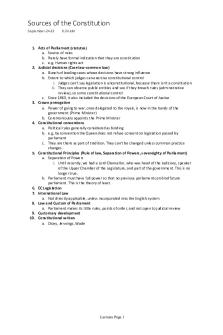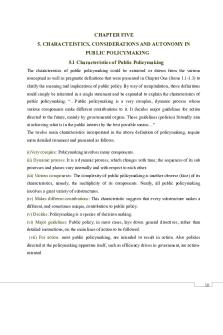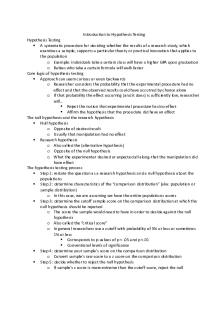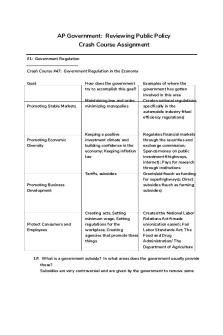Chapter FIVE po - Lecture notes PUBLIC POLICY PDF

| Title | Chapter FIVE po - Lecture notes PUBLIC POLICY |
|---|---|
| Author | Jemal Ali Salah |
| Course | Public policy |
| Institution | Mekelle University |
| Pages | 11 |
| File Size | 141.1 KB |
| File Type | |
| Total Downloads | 117 |
| Total Views | 199 |
Summary
JEMAL ALI...
Description
CHAPTER FIVE 5. CHARACTEISTICS, CONSIDERATIONS AND AUTONOMY IN PUBLIC POLICYMAKING 5.1 Characteristics of Public Policymaking The characteristics of public policymaking could be extracted or drawn from the various conceptual as well as pragmatic definitions that were presented in Chapter One (Items 1.1-1.3) to clarify the meaning and implications of public policy. By way of recapitulation, those definitions could simply be reiterated in a single statement and be expanded to explain the characteristics of public policymaking. “…Public policymaking is a very complex, dynamic process whose various components make different contributions to it. It decides major guidelines for action directed to the future, mainly by governmental organs. These guidelines (policies) formally aim at achieving what is in the public interest by the best possible means…” The twelve main characteristics incorporated in the above definition of policymaking, require more detailed comment and presented as follows. (i)Very complex: Policymaking involves many components. (ii) Dynamic process: It is a dynamic process, which changes with time; the sequences of its sub processes and phases vary internally and with respect to each other. (iii) Various components: The complexity of public policymaking is another obverse (face) of its characteristics, namely, the multiplicity of its components. Nearly, all public policymaking involves a great variety of substructures. (iv) Makes different contributions: This characteristic suggests that every substructure makes a different, and sometimes unique, contribution to public policy. (v) Decides: Policymaking is a species of decision making. (vi) Major guidelines: Public policy, in most cases, lays down general directives, rather than detailed instructions, on the main lines of action to be followed. (vii) For action: most public policymaking, are intended to result in action. Also policies directed at the policymaking apparatus itself, such as efficiency drives in government, are actionoriented.
10
(viii) Directed to the future: This is one of its most important characteristics, since it introduces the ever-present elements of uncertainty and doubtful predictions that establish the basic tone of nearly all policymaking.
(ix) Mainly by governmental organs: One of the differences between making private policy and making public policy is that the latter mainly concerns actions to be taken by governmental organs. (x) Formally aims at achieving: One characteristic of all contemporary political systems is that formal aim is to achieve what is in the public interest (xi) What is in the public interest: (xii) By the best possible means: Public policymaking formally aims not only at achieving what is in "the public interest," but at doing so by the best possible means. In abstract terminology, public policymaking aims at achieving the maximum net benefit (public interest achieved at less cost of achievement). These twelve main characteristics of public policymaking are largely shared with other related processes, especially with decision making, which is a broader concept and includes policymaking, and with planning, which is also a species of decision making and often overlaps policymaking. Sometimes planning is a major means of policymaking characterized by being relatively more structured, explicit, and systematic, and by presuming to be more rational. The discussion will focus on public policymaking, but most of its points will apply also to private policymaking, decisionmaking, and planning. From time to time we will mention some main differences between these related processes to help the interested reader apply the analysis to them. 5.2 Power in Public Policymaking At any point when public policy is the subject of discussion, it is inevitably important to critically examine the power of policymakers since policymaking is essentially the manifestation of power (Sapru, 2004:93). In other words, it is important for anyone who tries to study the public policymaking process to understand exactly how power is exercised in the policymaking
10
process-how policymakers take decisions. In broad sense, the ability to win in social conflicts and thereby secure one's goals in the face of opposition is the fundamental nature of power. Power, alternatively known as autonomy, is described as the ability to bring about some change in the behavior of people. In a social context, it is defined as “the capacity of an individual or group of individuals, to modify the conduct of other individuals or groups in the manner which they desire”. In terms of public policy, power may be defined as the capacity of an individual, groups, or holders of offices to determine policy decisions (Sapru, 2004:93). As power is exercised by different bodies, each set of forces impose certain influences, which taken together, make up the policymaking process. This is to say that there is a ‘process’ through which public policy is made. The process, hence, consists of the complex interrelationships of the decisions made under the influence of powerful individual and groups. As Sapru underscored, because power is exercised by different parties, policymaking is an extremely complex analytical and political process to which there is no beginning and or end, and the boundaries of which are most uncertain. 5.2.1 The Power of Public Administration The power that public administrators can exert on the policy cycle depends on three major factors. First, the more intensively a government agency is already involved in the issue when it reaches the public agenda, the greater the role that its administrators play is likely to be. Remaking of policy depends heavily on how the previous experience is interpreted, and those who have managed that experience often do so most compellingly. Second, administrators have greater power when the issue to be decided is complex, whether technologically, financially, or organizationally. The details of space exploration, cancer-causing chemicals, and foreign trade controls bewilder most policymakers, who readily defer to those who can speak with expertise on those details. When most of the experts are outside of government, as is common, the private sector exerts the dominant influence.
Third, government administrators can exert power by forming coalitions with private interests. Every current and prospective public program has certain beneficiaries, and, when they are mobilized, they can augment the influence administrators bring to bear. There is thus no clear line between the power of a private interest group and a public agency when they mutually press for a certain policy decision. Scholars use the "iron triangle" model to denote this close three-
10
way relationship among an administrative agency, one or more private interest groups, and the legislative committees responsible for their concerns. Each exerts power or influence on the other two through their regular communications, and each simultaneously provides services or political support that the others need. 5.2.2 The Public Policymakers Policymaking involves a large number of persons and institutions and authorities: chiefs, executives, legislators, judges, administrators, councilors, monarchs, political parties, interest groups, experts and professionals. In this section, therefore, an attempt is made to explain how groups and organizations bring influences to bear on those who are vested with the power of taking and enforcing decisions. Such decisionmakers comprise of those who occupy formal offices within the constitutional system of rules. As Sapru noted, politics and policymaking are activities in which people with different sets of values compete for those positions within the political system which assign their occupants the right to take decisions or impose decisions on others. There are activities as well in which non-official groups seek to influence the decision taken by occupants of formal offices. This dimension examines the influence of those who are away from the centers of policymaking but who, in a particular situation, may perform one or more of the specialized roles which constitute influential behavior. Hence the policymakers can be simply categorized as official, who are directly involved in making decisions, and unofficial, who make significant influence on the content and nature of policy through indirect ways. We shall first identify who the official policymakers are and elaborating how they are involved in policymaking. Official policy-makers are those who are legally empowered to formulate public policy. These include legislatures, executives, administrators, and judges (Johnson, 1992; Sapru, 2004). Legislature: The legislature formally performs the task of law making in a political system. This doesn't necessarily mean that the legislature has an independent decisionmaking power or actually frames the official policy since political parties, pressure groups, and so forth can influence it. But it can safely be concluded that the legislature is more important in policy formulation in democratic than in dictatorial systems, and within the democratic systems, it tends to have greater independency in policy formulation in presidential systems (USA) than in the parliamentary (British) systems.
10
Executive: Modern governments everywhere mainly depend upon executive leadership both in policy formulation and execution. In developing countries in particular, the executive has even more influence in policymaking than in developed countries because of the greater concentration of power in the hands of the government with less responsiveness to the legislature. Administrative Agencies: although it has been an accepted doctrine in political science that administrators were merely implementers of policies determined by other organs of the government, such distinctions are now found to be fallacious as politics and administration are blended, and as administrators are highly involved in policy formulation in the modern world. The technical complexity of many policy matters, legislature's lack of time and information are among the major reasons for administrative agencies to have a formally recognized discretionary authority to formulate policies. Public officials are associated with policy formulation in three important ways: (a)
They have to supply facts, data and criticism about the workability of the policy to the legislature if the initiative for policymaking comes from them. In addition, since members of the parliament might have lack of administrative acumen (intelligence) or experience on technical or purely professional matters, they have to give due recognitions and rely on the suggestions of the officials,
(b)
Since the administrations are supposed have constant contact with the general public and thereby to be in a better position to understand the difficulties that arise in the implementation of policies, the initiative for policy legislation or amendments originates very often from the administration.
(c)
On account of lack of time and knowledge, the legislature passes skeleton acts and leaves the details to the administration.
The Courts: in countries where the courts have the power of judicial review, they have (as in the US) played an important role in policy formulation. They can affect the nature and content of public policy through exercising their judicial review and statutory interpretation power in cases brought before them. Determining the constitutionality of actions by legislative and executive branches of the government is basically the functions of the judiciary. The courts also specify the government's limits to actions and states what it must do to meet legal or constitutional obligations.
10
Besides the official policymakers, many unofficial bodies may participate in the policymaking process. These may include political parties, interest groups, and individual citizens. These unofficial bodies could participate in public policymaking in terms of expressing demands, supplying official policymakers with much technical information about specific issues and possible consequences of a policy proposal, and presenting alternatives for policy actions. They may considerably influence policy formation without possessing legal authority to make binding policy decisions.
Pressure Groups: Interest or pressure groups play an important role in policymaking in most countries. The strength and legitimacy of groups differs from country to country, depending upon whether they are democratic or dictatorial, developed or developing. Pressure groups are found to be more numerous in the United States or Great Britain than they are in the Soviet Union or China. The main function of these groups is to express demand and present alternatives for policy action. They may also supply the official lawmakers with much technical information for and against a specific issue and possible consequences of a policy proposal. Given the plural character of a certain society, it is not surprising that pressure groups are many and varied in number, interests, size, organization and style of operation.
Their influence also depends on other factors like numerical strength, monetary and other resources cohesiveness, leadership skills, social status and attitudes of the policymakers on specific policy issues.
Political Parties: In modern societies generally, political parties perform the function of “interest aggregation”, that is, they seek to convert the particular demands of interest groups into general policy alternatives. The number of parties affects the way in which parties “aggregate” interests. In predominantly bipartite systems such as the United States and Great Britain, the desire of the parties to gain widespread electoral support will forces both parties to includes in their policy proposals popular demands and avoid alienating the most important social gropes. In multipart systems, on the other hand, parties may do less aggregating and act as the representatives of fairly narrow sets of interests as appears to be the case in Finances.
10
In parliamentary states, the political party, which has a majority of votes in parliament, forms the government, which is the chief official policymaker. Needless to say \, most of the governments make policies according to the policy manifestos on which they have been elected to office. In presidential systems like the United States, the fact that members of Legislatures often vote in accordance with their party policy, which party controls the Congress has significant policy implications.
The Individual Citizen: Since democratic governments are representative governments, it is often said that citizens are therefore, indirectly represented in all policymaking. In an abstract sense, this is true, but concretely, this aphorism means very little. Citizen participation in policymaking, even in democratic countries, is very negligible. Many people do not exercise their franchise or engage in party politics; they neither join pressure groups nor display any active interest in public affairs. Even while voting, voters are influenced comparatively little by policy considerations.
However, it is a truism that no government, however dictatorial, can afford to go against the desires, wishes, customs or traditions of the people. Even dictators will undertake many popular measures to keep down unrest or discontent against the regime. One-party systems like the Soviet Union also seem concerned to meet many citizen wants even as they exclude citizens from move direct participation in policy formation. 5.3 Determinant Factors in Public Policymaking After identifying the official policy-makers and specifying the areas and scopes for which each party will have concern and authority, it would be important also to overview the relevant factors determining policy formulation or factors that policymakers should take into account. Policy formulation in practice often overlaps with the policy decision stage of the policymaking process. Formulation aims at getting a preferred policy alternative approved; an affirmative decision is the reward of the whole process.
A policy decision involves action by some official person or body to approve, modify or reject a preferred policy alternative. If positive, it takes such forms as the enactment of legislation or the issuance of an executive order. What is typically involved at the policy-decision stage is not
10
selection from among a number of full-blown policy alternatives but rather, action on what is chosen to call a preferred policy alternative-one for which the proponents of action think they can win the formulation process moves towards the decision state, some proposals will be rejected, others accepted, still others modified, differences will be narrowed, bargain will be narrowed, bargain will be struck, until eventually in most cases, the policy enactment will only be a formality.
All these sequential activities are the results of many considerations in the policymaking process. From the start, identified policymakers (especially the official ones) takes into account several determinant factors and consider all with assigned respective values in the process. Public policymaking considers, for example public opinion, rationality of the process, political and socio-economic situations or variables. Public Opinion: Public opinion is central in shaping the content of public policymaking. Democratic Constitutions provide freedom of expression. Popular sovereign confer upon the legal sovereign the role to determine national policies. Initiative and Referendum confirm people's role in policy- making. Political parties, mass media, newspapers, television claim to represent public opinion. Rationality: Rational policy analysis, as has been discussed in depth in the preceding chapter, involves the following steps: (i)
Identify the problem requiring policymaking
(ii) Clarify and rank goals (iii) Collect the relevant alternatives & information (iv) Calculate the consequences of each alternative on the basis of cost-benefit analysis (v) Select the alternative, which comes closest to achieving the goal Policymaking cannot be adequately understood apart from the environment in which it takes place. Demands for policy actions are generated in the environment and transmitted to the political system. At the same time, the environment places limits and constraints upon what can be done by policymakers. Hence, environment is a decisive factor on public policy formulation. Environment, in turn, includes geographical characteristics as natural resources, climate and topography; demographic variables like population size, age and sex ratio distribution and spatial location; political culture; social structure; and the economic system. Actions of politicians,
10
legacy of the past, nature of the government organizations, economic systems pose constraints in policymaking. Other nations become a significant part of the environment for foreign and defiance policy. The discussion here will focus on two these environmental factors to which political scientists have given much importance to, namely, political culture and socio-economic variables. Policy formulations in every country is, in the words of Sickle Hudson, “arrived at, then, in all sorts of ways, conditioned by all sorts of matters.” Of these environmental aspects, political culture and socioeconomic variables are considered as the more influential factors in public policy formulation. Political Culture: culture has been defined as the entire pattern of social life, the inherited modes of living and conduct that the individual acquires from the community or environment. Most social scientists agree that culture is one of the many factors that shape or influence social action. Political culture is also part of the general culture, which denotes widely held values, beliefs, and attitudes concerning governme...
Similar Free PDFs

Public Law - Lecture notes - Public
- 48 Pages

Public Policy Essay
- 3 Pages

Public Policy Analysis paper
- 15 Pages

Public Policy Assignment
- 4 Pages

Public Policy - Elarba Badih
- 3 Pages

Reading Article - Public Policy
- 2 Pages

Agreements Against Public Policy
- 6 Pages
Popular Institutions
- Tinajero National High School - Annex
- Politeknik Caltex Riau
- Yokohama City University
- SGT University
- University of Al-Qadisiyah
- Divine Word College of Vigan
- Techniek College Rotterdam
- Universidade de Santiago
- Universiti Teknologi MARA Cawangan Johor Kampus Pasir Gudang
- Poltekkes Kemenkes Yogyakarta
- Baguio City National High School
- Colegio san marcos
- preparatoria uno
- Centro de Bachillerato Tecnológico Industrial y de Servicios No. 107
- Dalian Maritime University
- Quang Trung Secondary School
- Colegio Tecnológico en Informática
- Corporación Regional de Educación Superior
- Grupo CEDVA
- Dar Al Uloom University
- Centro de Estudios Preuniversitarios de la Universidad Nacional de Ingeniería
- 上智大学
- Aakash International School, Nuna Majara
- San Felipe Neri Catholic School
- Kang Chiao International School - New Taipei City
- Misamis Occidental National High School
- Institución Educativa Escuela Normal Juan Ladrilleros
- Kolehiyo ng Pantukan
- Batanes State College
- Instituto Continental
- Sekolah Menengah Kejuruan Kesehatan Kaltara (Tarakan)
- Colegio de La Inmaculada Concepcion - Cebu








